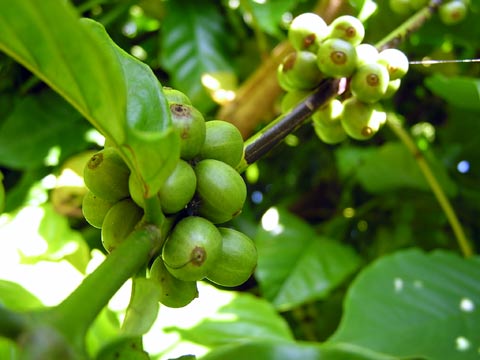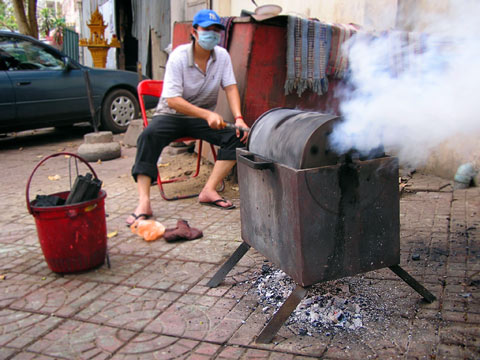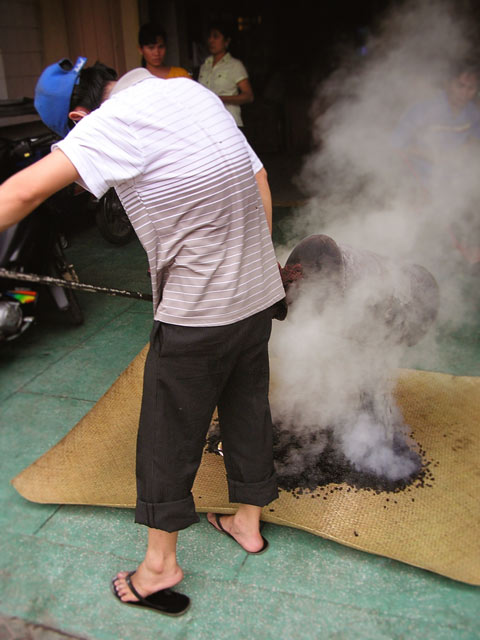One of the rare disappointments that I’ve had when hunting the provinces for Cambodian food is finding Cambodian coffee. I’ve been to the far northeast, met the growers in their villages, and then wandered about Banlung in search of fresh Java with increasing and unfulfilled desperation.
What I ended up discovering in my brief Ratanakiri-ward sojourn is that there is a disconnection between growing and roasting coffee within Cambodia. Rumour has it that a Cambodian roastery briefly existed in Ratanakiri until growers were offered a better price from Vietnamese buyers. Bulk beans are now shipped from Cambodia’s north east, processed across the border in Vietnam, then imported back to Cambodia as a finished product. While I can confirm the rumour with at least one bulk coffee vendor in Phnom Penh, it still has an air of disingenuousness about it because on a small scale, coffee is easy to roast. All you need is an oven, some patience and a good deal of practice. Or alternately, a popcorn popper.
Thus it was an embarrassing bitch slap to the face to discover that a café within walking distance of my house roasts local beans. The process is relatively simple. Sok (pictured) rotates the beans in a metal drum over white hot charcoal.
When they approach the correct degree of blackness (Phnom Penhois tend to prefer a black-as-pitch roast), Sok adds a cup of rendered pork fat, gives the drum a few more quick rotations to let the fat partly burn off, then dumps them onto a waiting mat to cool.
The coffee smoke is so rich that I’m surprised that I could not smell it from my house and I’m still not sure of the best method to remove it from my clothes. I’m not even sure if I want to remove it.
I find it comforting that even my coffee has meat in it, vegans probably less so.
Location: Corner of st.432 and 155, near Psar Tuol Tom Poung (Russian Market). Coffee is roasted in the afternoons around 3pm.




Thats very cool… I’ve heard of some interesting things being added to the roaster before… but pig fat takes the cake…
Do you know what kind of coffee is grown in the area ? Like Robusta or Arabica ?
How do they drink the coffee at this cafe within walking distance to your house? Do they uses those strange metal cup contraptions like in Vietnam. I was in Banda Ache Last year and they used a sock like strainer with lots of Barista flair. It was pretty week and not like I’m used to, it was like they’d used the same grounds over and over. Maybe you had to get there early in the morning for the best glass?
How do Phnom Penhois drink their coffee? Do you drink they coffee there, or do you take it away?
Once again showing that there is no food in Cambodia that can’t be improved with addition of a little pork. I’m guessing Cham Muslims may use a different kind of fat…
Great post! The pork fat addition is interesting to say the least. I’ve heard that most of the Cambodian coffee is sold to Nescafe, is this true?
Pig fat on the beans – brilliant! (but problematical if you are a coffee-loving Jew or Muslim).
Simon – the sock method of brewing coffee is common to Indonesia, Malaysia, and Thailand. We’ve travelled a bit on Sumatra and found – like you – that the coffee is often curiously weak. Depends a bit on the pondok kopi you’ve wandered into. You can ask for it ‘dark’ as well.
Simon – I’ll do a follow up post on drinking the same coffee. All will be answered.
Melissa – It depends where you go as to whether you get Nescafe or not. Most roadside cafes brew from scratch, but quite a few of the more backpackery restaurants serve Nescafe.
The sock method of brewing is most prevalent but generally the coffee is served with little flair. As for varieties, the coffee planted tends to be robusta, but I’ve seen an intriguing reference to “Cambodian robusta ( a hybrid originally from Africa called Catimor)”(?) at http://www.stanford-jc.or.jp/research/column/fromkyoto/2003/09.html
A few years ago, while wandering around Kratie, we found coffee roasters by the roadside. I don’t know about pig fat, but you can see a photo here http://www.onasia.com/system/preview.aspx?pvp=jre0110820.68.
Our favorite local coffee hangout in Phnom Penh (run by a family from Kampuchea Krom) does the sock trick. The 20-something son used to do a brilliant little dance every time he served a cup. But now he’s working as a repairman at a shop up the street. No more coffee dance, but damn good coffee nonetheless.
But the key question: is the coffee any good?
Your coffee questions will be answered on Monday. No sooner.
Oy.
I’m currently in Cambodia, hot on the coffee trail. I had planned a trip to Ratanakiri to visit the coffee plantations. Rumor has it, they grow a little Arabica, some of which is being exported in small quantities to Japan, of all places.
Most of the ‘local’ coffee I’ve tasted has been pretty bad. Bad beans, bad roasting. I’m more than half serious about starting a coffee roastery here in Phnom Penh and selling to all of the Western-oriented cafes.
Pork fat. Wow.
Oh. I didn’t mention that my trip to Ratanakiri was aborted due to an unexpected illness of one of my travelmates. Next time.
The Japanese roasters are http://ratanakiri-coffee.com/ – they export the beans to Japan for roasting.
if you want really good coffee in sumatra. sidikalang where its grown and the small villages in west aceh where they cook the beans in a wok. the smell drifts over the beach. its delicious. sometimes the coffee is cut with a little corn. another reason it may taste a little weak.
i lived in phnom penh in 2000 and had a coffee plunger. i remember the cambodian beans never looked good and I mostly bought Laotian. a shop near central market ground them fresh for me.